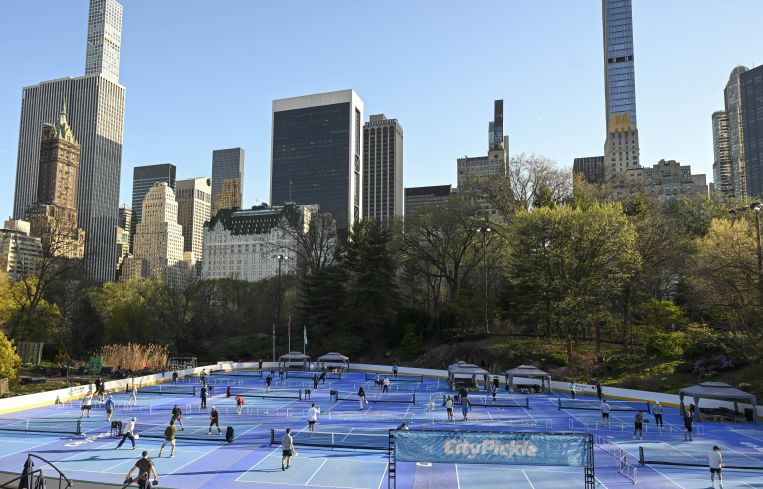Pickleball and Commercial Real Estate: A Perfect Match
The booming sport can usually fill a niche — and a space — in markets nationwide
By Celia Young May 22, 2023 7:00 am
reprints
It’s crunch time for pickleball in New York and nationally, as more players than ever flock to the quirky court sport and property owners take notice.
The racket game was dubbed the fastest-growing sport in the U.S. by the Sports & Fitness Industry Association, with the number of players older than 6 years old growing from 4.8 million in 2022 to 8.9 million in 2023. Courts have cropped up nationwide, from Central Park to South Boston to the suburbs of Washington, D.C. Everyone, their mother and even their grandmother seems to be playing. And before long, you might be too.
“As I tell everybody, be careful if you try pickleball because you will be addicted for life,” Dave “Badger” Weinbach, a 10-time U.S. Open champion in pickleball, told Commercial Observer.
To Weinbach, who’s been serving up his skills on the pickleball court for more than a decade, the sport’s growing popularity is no surprise. It’s cheap, easy to get started, and a great workout if you want it to be, he said. And landlords and real estate brokers alike are starting to take notice — or take to the game themselves.
In New York, CityPickle launched 14 courts at Central Park’s Wollman Rink on April 7 with plans to stay open until Oct. 13, 2023. Founded by doubles tennis partners Erica Desai and Mary Cannon, CityPickle has dabbled in pickleball pop-ups in other neighborhoods, including Hudson Yards and the TWA Hotel at John F. Kennedy International Airport.
The duo swung big with Wollman, which they say represents the largest number of courts in the Northeast. CityPickle also plans to open a permanent location with four courts at 9-03 44th Road in Long Island City, Queens, for lessons, classes and organized leagues, followed by more outposts in New York City and across the country.
Desai and Cannon said they are confident that if they build it, pickleballers will come.
“The demand for pickleball has grown, and everybody has read about and seen pickleball,” Cannon said. “Now I actually think that commercial property owners are understanding the unique value that pickleball can bring to their assets.”
Part of that value is pickleball’s smaller size and easier construction process compared to racket sports like tennis or squash. Roughly four pickleball courts can fit in a tennis court, according to USA Pickleball, the governing body of the sport in the nation. Pickleball courts can literally be rolled out onto a flat surface indoors or outdoors, compared to squash, which requires indoor space and solid walls, and which has waned in popularity for the past decade, according to industry publication SquashMad.
Related Companies, the developer that partnered with Equinox and Harris Blitzer Sports & Entertainment to bring pickleball to Central Park’s Wollman Rink — which the trio operates under a contract with the city and which CityPickle manages on a day-to-day basis — is exploring expanding pickleball at the company’s other properties in cities such as Chicago, Miami, Los Angeles and Boston. Related cites Wollman Rink’s popularity and the sport’s easy installation as reasons for the possible expansion.
“In an urban environment where real estate is scarce it’s a great way to maximize the value of the land,” Greg Gushee, executive vice president at Related Companies, said.
The weekend of May 6 and 7, 1,199 people played pickleball at Wollman Rink, followed by another 1,244 people who played the following weekend, according to CityPickle. And the sport has also gained traction with another major city landlord: Brookfield (BN) Properties.
Brookfield offered free pickleball in its mall, dubbed Brookfield Place, at 230 Vesey Street in the Financial District. Its two-court program was fairly easy to set up and monitor, and it attracted more than 1,000 people from May 2 through May 14 this year, said Callie Haines, executive vice president of the Northeast for the landlord.
In the Washington, D.C., region, pickleball has exploded. A group of investors announced plans to open a 22,917-square-foot indoor pickleball facility dubbed The Dink of Severna Park, named after a soft shot in pickleball, at 254 Najoles Road in suburban Maryland this year, as Commercial Observer reported. Just in April, a husband and wife duo doubled the size of their pickleball complex at 9179 Red Branch Road in Columbia, Md., to a 30,000-square-foot facility with 12 courts.
That’s not to say finding space for pickleball courts has been without its challenges. Operators charging players to use indoor space in urban hubs like Washington, D.C., and New York have to compete with free, outdoor courts, said Timothy Schnupp, founder and president of the seven-court facility The Dink. And it’s not exactly cheap.
Schnupp spends around $30,000 a month on rent and spent around $1 million to build The Dink. The buildout included repairing the site’s concrete floors and installing drywall, a new $250,000 HVAC system, angled lighting to help visibility, and $50,000 on soundproofing, all in what Schnupp said was a rare investment for the industry because “it’s so damn expensive.” (The decision might be a popular one for players, given that residents and homeowner associations have rallied against the sport on account of the jarring and repetitive thwacking sound made when a pickleball meets a paddle.)
For the most part, building a pickleball court depends on the physical building an operator can lease, Schnupp said. If a tenant has to pour their own concrete, an individual court can run up a bill of $30,000 to $50,000, according to the Professional Pickleball Association, a pickleball tour organizer. If an operator chooses to buy a special court surface that can be rolled onto a flat space, the cost usually ranges from $15 to $40 per square foot, according to court seller SportMaster.
Pickleball also requires open, column-free space with a minimum of 18-foot-high ceilings, a tough sell in most metropolitan areas, Desai added.
“I do think the size of the pickleball court makes it a bit easier to find space,” Desai said. “But, in New York City, as is the case in many urban areas, tall buildings are held up by columns. And columns tend to be 20 feet apart, which is not enough for a pickleball court. I think that is probably part of what makes having athletic facilities in urban areas particularly challenging.”
That might help explain why indoor pickleball spaces, like CityPickle and The Dink, have found homes in suburban areas or the outer boroughs when it comes to New York City. And, nationally, pickleball users like Ace Pickleball Club have looked to create courts in places such as former Bed Bath & Beyond outposts, ex-grocery stores, former warehouse spaces and even old office space, said Nena Mass, a senior vice president with CBRE who represents Ace Pickleball Club nationwide.
“We tell our brokers to take a look at anything we can repurpose, whether it’s flex space, industrial or office,” Mass said. “But your ability to find more space will probably be better in a suburban environment to start off with.”
Pickleball also tends to draw a broad crowd, making parking necessary at suburban facilities, but also keeping the sport popular, Mass added. The sport’s smaller courts make the game easy for young children and older folks, plus players can talk while volleying a plastic ball back and forth, said Jones Wong, an assistant managing director for field operations of the USA Pickleball Association.
“You get to meet people, it’s a relatively easy sport to learn, [though] it’s much harder to get really good at; but you’re gonna have fun just playing in the very beginning,” Wong said. “And it doesn’t cost a whole lot.”
That social aspect has taken on an even more powerful meaning after the pandemic, which caused a bump in the outdoor recreation industry and in the number of U.S. pickleball players.
Participation in pickleball grew 40 percent between 2019 and 2021, as Americans flocked to the sport as an outdoor pastime during the pandemic, according to U.S. News & World Report. That momentum hasn’t slowed, with more than 36.5 million people playing the game between August 2021 and August 2022, CNBC reported.
“People really realize the value of outdoor space,” Brookfield’s Haines said. “Our outdoor space is a place that people want to be, and [that] certainly helps with bringing people back to the office as well.”
While the pandemic may have disappeared from headlines and news alerts, pickleball remains. And Desai, the CityPickle co-founder, expects the sport to remain popular as people continue to seek social connections in the wake of a multiyear hibernation.
“Now that the pandemic is a little more behind us, I think that people are really craving opportunities to come together in real life,” Desai said. “It’s kind of the perfect moment to give people the opportunity to come back together.”
Celia Young can be reached at cyoung@commercialobserver.com.


